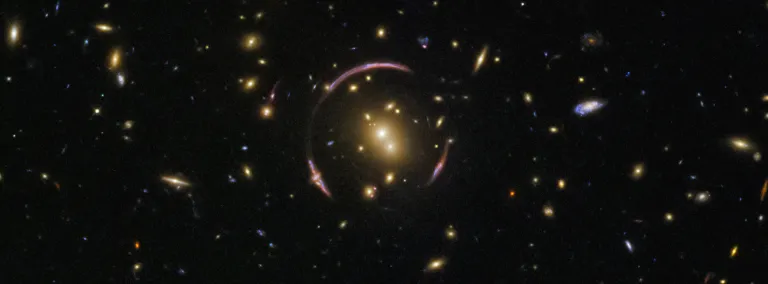What is dark matter?
How do we know this elusive particle exists? We see it in the stars.
There is a phenomenon that occurs when light from a very distant object—like a galaxy—gets bent by gravity around an object, creating a halo of light. Called gravitational lensing, or an Einstein ring after physicist Albert Einstein, the phenomenon points to the existence of dark matter, an elusive particle that makes up nearly 85 percent of all the matter in the universe.
“The way the light bends allows us to measure the mass of a galaxy cluster,” said Sally Shaw, a post doc at the University of California Santa Barbara (UCSB) who is part of the LUX-ZEPLIN dark matter experiment.
“Gravitational lensing is one of several ways we’ve learned that clusters of galaxies are embedded in big groupings of dark matter,” added Harry Nelson, a physicist with UCSB and a member of the LZ collaboration. “The bending of light next to clusters of galaxies is much more pronounced than can be explained by the mass of visible objects in luminous galaxies, alone.”
In addition to gravitational lensing, other indirect evidence points to the existence of dark matter.
Gravitationally speaking
“We don’t know what dark matter really is, yet it completely dominates the behavior of the universe gravitationally,” said Rick Gaitskell, a member of the LUX-ZEPLIN dark matter collaboration and a professor of physics at Brown University. “But we can observe it through its gravitational effect in the rotation of galaxies.”
Most of the stars cluster near the center of the galaxy so the assumption for many years was that the majority of the mass and gravity was there as well. Not so. In the 1970s, American astronomer Vera Rubin discovered that stars in the outer regions of spiral galaxies move just as quickly as stars near the center.
“We find that these galaxies and galaxy clusters rotate so fast, they simply can’t be held together by the gravity of their ‘visible’ matter,” Shaw said. “That tells us there has to be something dark that is, in fact, most of the total mass of the object.”
The cosmic microwave background
The Big Bang theory tells us the early universe was extremely hot—but as it expanded, the gas within it began to cool, leaving behind relic radiation that is called the cosmic microwave background (CMB), Shaw said.
“As the universe progressed, dark matter began to coalesce into proto-galaxies and their clusters,” Nelson said. “Matter fell into these groupings of dark matter, heated up and expanded then re-collapsed, leaving a sort of fingerprint on the CMB.”
Essentially, dark matter clusters “seeded” galaxy formation in the early universe.
“Galaxies are primarily made up of dark matter and our matter is constantly falling into it. But due to initial velocity, our matter ends up circling the dark matter,” Nelson said. “The idea is that the faster things move in their circular orbits, the stronger the force trying to pull them to the center. When you add up the total mass of the dark matter in a typical galaxy, it usually exceeds the mass of the stars and other visible matter by a factor of 5 to 10, just as it does in the CMB.
Looking for direct evidence
Galaxy rotation, cosmic microwaves, and gravitational lensing give indirect evidence that there has to be more to the universe than what can be seen. But for the thousands of dark matter researchers around the globe, it’s not enough.
Shaw, Nelson and Gaitskell are all part of the LZ collaboration, an experiment that is seeking direct evidence of the existence of dark matter.
LZ, which is being assembled at Sanford Lab on the 4850 Level, will use 10 tons of liquid xenon to search for WIMPs, weakly interacting massive particles, the leading theoretical candidate for a dark matter particle.
“We are trying to answer all the big questions. Why are we here? Where did we come from? Why is our universe like it is?” Shaw said. “As physicists we are interested in the very fundamental nature of matter. The fact that these particles that make up our universe all came together in just the right way to form life with consciousness is truly astounding and we want to understand how it happened.”
And what happens if scientists do find dark matter?
“It may help solve further big mysteries in the universe, including dark energy. If we solve these mysteries and expand our understanding of physics, who knows what could follow in terms of improving the world for all its living species,” Shaw said.
